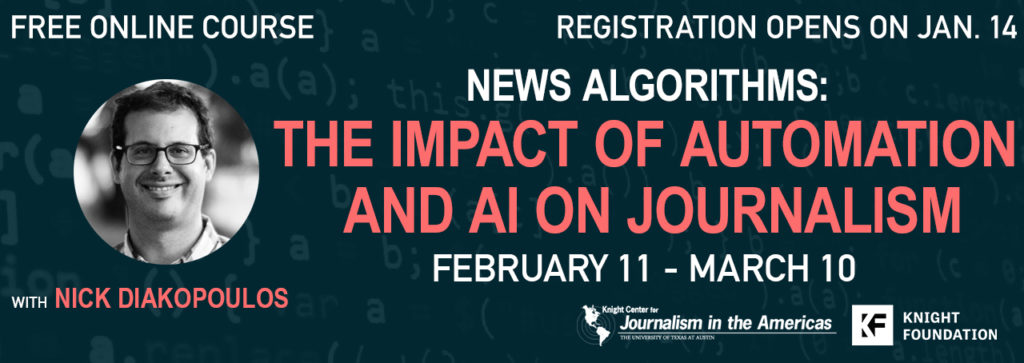
Newsrooms around the world are using automation to produce earnings reports, identify fact-checkable statements, and provide updates on court cases, among other functions. It’s now imperative that journalists understand the power and pitfalls of these technologies.
In the Knight Center’s upcoming free online course, students will learn about how news media are using algorithms, automation and AI to do journalism and how they can apply these tools in their own work.
Sign up now for the massive open online course (MOOC), “News Algorithms: The Impact of Automation and AI on Journalism.”
“It’s really about understanding these technologies at a pretty high level and demystifying these technologies for the students so that they can understand how to be more strategic with these technologies, how to potentially use these technologies in their work or just to be more thoughtful and responsible in how they use these tools or maybe report on these technologies,” said Diakopoulos, author of “Automating the News: How Algorithms Are Rewriting the Media.”

The course is offered for free thanks to support from the John S. and James L. Knight Foundation.
The course is divided into four weekly modules:
“I want students to be able to think strategically, creatively and responsibly about the adoption of these technologies in their work,” Diakopoulos said.
Each weekly module will consist of video lessons, readings, quizzes and participation in discussion forums. Like all Knight Center courses, this MOOC is asynchronous, so students can complete the activities during the days and times that are most convenient. However, there are suggested deadlines so you don’t fall behind.
In discussion forums, students will be asked questions to apply their learning. For example, they’ll identify tasks they carry out on a routine basis and whether algorithms might be able to help. Students will also be asked to review the behavior of bots that work via social media and potential uses for automation in the newsroom. They’ll also monitor potential limitations of algorithms that use autocompletion.
The aim is for students to continue to identify how these systems are used in the world and how they might incorporate them in their own newsrooms.
Thoroughly knowing the capabilities and limitations of these technologies will ensure that students don’t think of them as a kind of “magic,” Diakopoulos said.
Diakopoulos is an assistant professor in the Department of Communication Studies at Northwestern University’s School of Communication and director of the Computational Journalism Lab. He is also a Tow Fellow at Columbia University Journalism School in New York City. He previously co-founded the program in Computational Journalism at Georgia Tech, where he also received his Ph.D. in Computer Science.
“We are lucky to have Dr. Diakopoulos as an instructor for this course, as he is an expert in this field and knows how to explain the complex issues involved in algorithms and artificial intelligence used by news organizations in a simple and direct way,” said professor Rosental Alves, founder and director of the Knight Center.
“We are entering a new phase of the digital revolution, with algorithms and artificial intelligence being used everywhere. It’s time for journalists to get ready for this new era,” Alves said.
The course has been prepared with journalists in mind, but it is open to anyone who wants to learn about algorithms, automation and artificial intelligence and how these techniques can be used in news production. No technical ability is needed.
The MOOC is free, but students who successfully complete course requirements and pay an administrative fee of U.S. $30 will receive a certificate of completion in PDF format. No formal college credit is associated with the certificate.
Sign up now for this latest Knight Center course and learn more about how emerging technologies can help you in the newsroom.
About the John S. and James L. Knight Foundation
The Knight Foundation is a national foundation with strong local roots that invests in journalism, the arts and in the success of cities where brothers John S. and James L. Knight once published newspapers. Its goal is to foster informed and engaged communities, which it believes are essential for a healthy democracy. For more, visit kf.org.
About the Knight Center
The Knight Center for Journalism in the Americas was created in 2002 by Professor Rosental Alves, Knight Chair of Journalism at the Moody College of Communication at the University of Texas, thanks to the generous donations of the John S. and James L. Knight Foundation. The Knight Center’s distance learning program began in 2003 and is funded in part by the Knight Foundation. Over the past six years, the Knight Center MOOCs have reached more than 170,000 people in 200 countries and territories.

Knight Center for Journalism in the Americas
300 West Dean Keeton
Room 3.212
Austin, TX, 78712
Phone: 512-471-1391
Email: journalismcourses@austin.utexas.edu